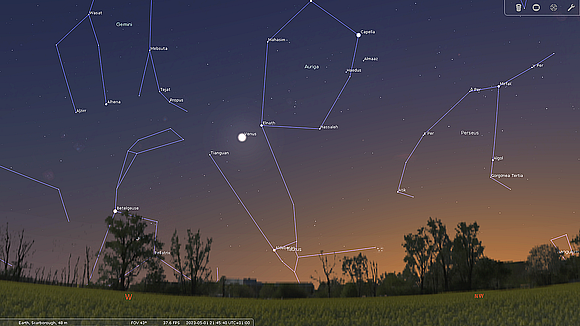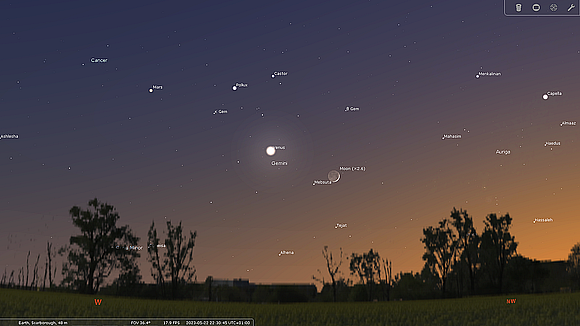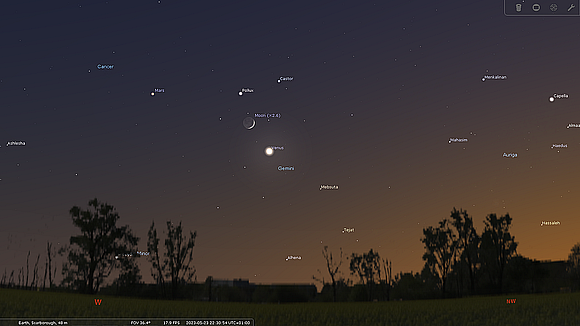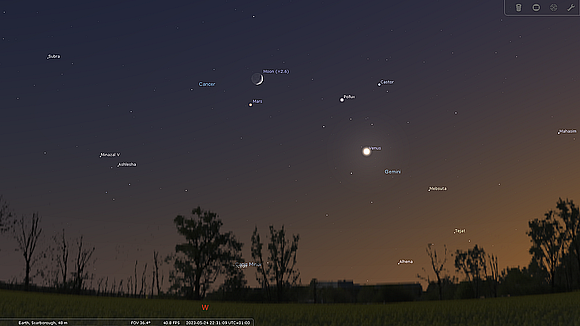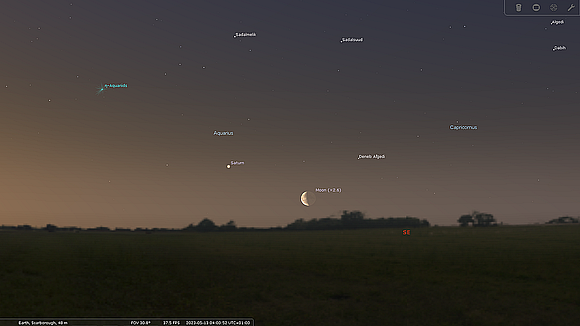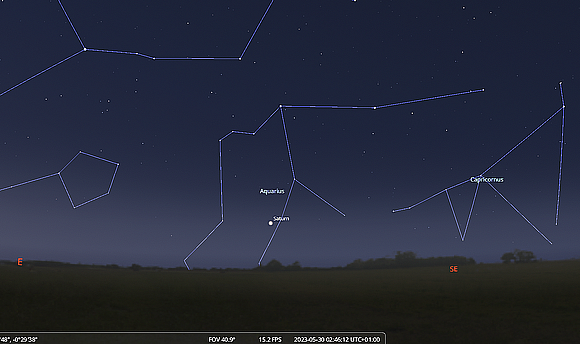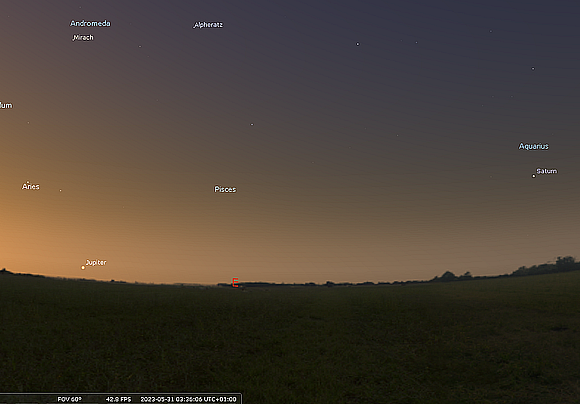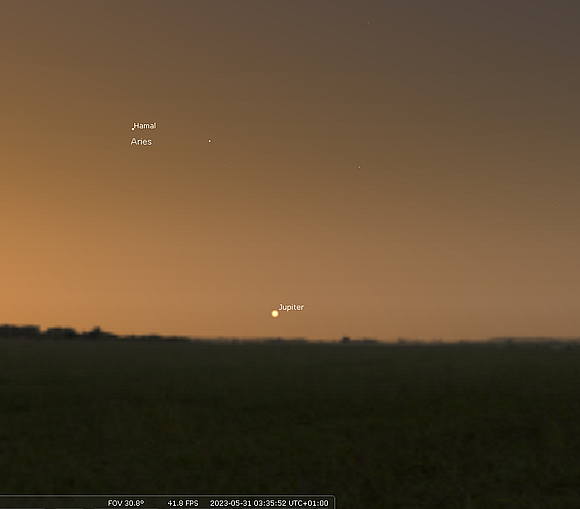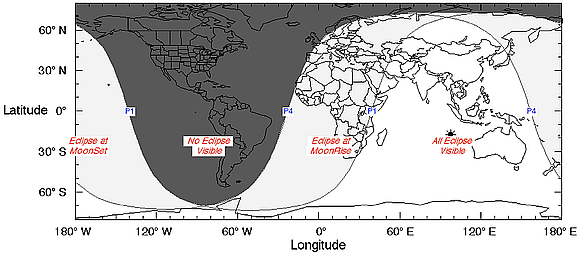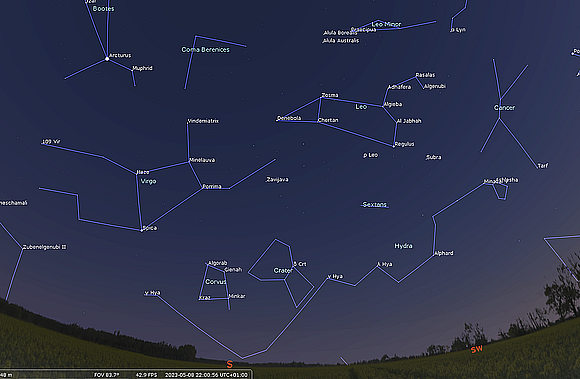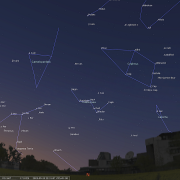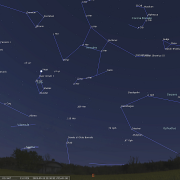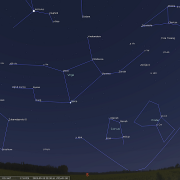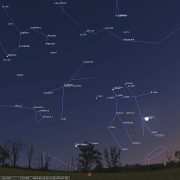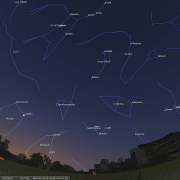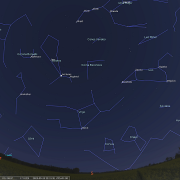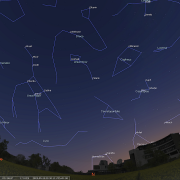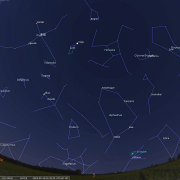In this month's Sky Notes:
- Planetary Skylights.
- May Meteors, penumbral lunar eclipse and NCC.
- May Night Sky.
- May 2023 Sky Charts.
Planetary Skylights: A Brief Guide to April's Night Sky
Venus rules the twilight sky. Mars is now a pale imitation of what it was last December. Saturn is apparent in the dawn sky, which sees the return of Jupiter at the end of the month.
 The 'evening star' – Venus should be visible to the naked eye 20 minutes after sunset, but then dominates the sky in the west as twilight deepens. Venus is slowly starting to head back towards the WNW horizon during May but is still visible around midnight by the end of the month.
The 'evening star' – Venus should be visible to the naked eye 20 minutes after sunset, but then dominates the sky in the west as twilight deepens. Venus is slowly starting to head back towards the WNW horizon during May but is still visible around midnight by the end of the month.
Venus is best viewed in bright twilight, its brilliance is then negated to some degree, allowing observation of the phase and any subtle darker shading upon it. The magnitude increases from -4.1 to -4.2 over May, as the disk size grows from just over 17 arc seconds to almost 23 arc seconds, the phase itself being a shrinking Gibbous. At the start of May, Venus resides between the 'horn' stars in Taurus and begins to track up through the descending stars of Gemini. The crescent Moon pays Venus a visit on the 22nd and 23rd of May, making for a picturesque twilight scene.
Venus starts May 145 million Km distant from Earth, reducing to 109 million Km by the months end.
 Mars continues to linger in the evening twilight sky having tracked by Pollux in Gemini at the start of the month and is enroute for the faint stars of Cancer, crossing into the Crab's territory on May 26th. The Red Planet continues to diminish in brightness, ending the month at magnitude +1.5. appearing fainter than Pollux. The waxing crescent Moon lies above Mars on May 24th. Through the eyepiece Mars appears very small (under 5 arc seconds). By the end of May the red planet is drawing closer to Venus in the sky – low in the WNW but will still be visible for another month yet.
Mars continues to linger in the evening twilight sky having tracked by Pollux in Gemini at the start of the month and is enroute for the faint stars of Cancer, crossing into the Crab's territory on May 26th. The Red Planet continues to diminish in brightness, ending the month at magnitude +1.5. appearing fainter than Pollux. The waxing crescent Moon lies above Mars on May 24th. Through the eyepiece Mars appears very small (under 5 arc seconds). By the end of May the red planet is drawing closer to Venus in the sky – low in the WNW but will still be visible for another month yet.
 Saturn is slowly drawing away from the Sun in the early dawn sky, but is not visible in a dark sky until near the end of May, rising then around 02:30hrs. It will still be rather low to the ESE horizon so that observations with a telescope will be 'seeing restrictive' and limited to less than an hour. We shall have to wait another month in the northern hemisphere for better views, but still at unfriendly observing times! On May 13 & 14th a waning last quarter Moon passes below Saturn low to the horizon, view around 04:10 - 04:30hrs. Saturn is currently amongst the stars of Aquarius, not becoming a viable late evening target until mid-August.
Saturn is slowly drawing away from the Sun in the early dawn sky, but is not visible in a dark sky until near the end of May, rising then around 02:30hrs. It will still be rather low to the ESE horizon so that observations with a telescope will be 'seeing restrictive' and limited to less than an hour. We shall have to wait another month in the northern hemisphere for better views, but still at unfriendly observing times! On May 13 & 14th a waning last quarter Moon passes below Saturn low to the horizon, view around 04:10 - 04:30hrs. Saturn is currently amongst the stars of Aquarius, not becoming a viable late evening target until mid-August.
 Jupiter emerges into the dawn sky towards the end of May, visible just above the ENE horizon by 03:30hrs. It will only be a naked eye/binocular object to start with, taking another month before visible in a darkened sky, but at the unfriendly hour of 02:45hrs - the middle of the night for most!
Jupiter emerges into the dawn sky towards the end of May, visible just above the ENE horizon by 03:30hrs. It will only be a naked eye/binocular object to start with, taking another month before visible in a darkened sky, but at the unfriendly hour of 02:45hrs - the middle of the night for most!
May Meteors, Penumbral Lunar Eclipse and Noctilucent Cloud
The Eta Aquarid meteor shower is May's most active, the peak time and date falling in the predawn hours of the 6th. The shower's radiant is rather low for more northern hemisphere observers, with Aquarius only just rising in the early morning hours at this time of year. Observed rates would otherwise be considerably higher (ZHR of 25 - 30) instead of the 10-12 per hour normally visible. This is rather irrelevant for 2023, in any case with moonlight from a Full Moon washing out all but the brightest examples. The Eta Aquarids is one of two meteor showers associated with debris particles deposited over time by comet Halley, the other shower being the Orionids, seen in late October. View to the east, south, and high to the southeast around 03:00hrs, but only expect to spot a few examples.
The invisible penumbral eclipse
There is a penumbral lunar eclipse visible from most of Europe, central and far east Asia - including Australia and New Zealand overnight on May 5/6th. A penumbral lunar eclipse occurs when the Sun, Earth, and the Moon are imperfectly aligned. When this happens, Earth only partially blocks some of the Sun's light from directly reaching the Moon's surface, so that the lunar surface is only covered with the outer, lighter part of its shadow. Since the penumbra is much fainter than the darker core of the Earth's shadow, the umbra, a penumbral eclipse of the Moon is often difficult to tell apart from a normal Full Moon. For this penumbral lunar eclipse, the Moon passes deep into the outer part of Earth’s shadow, just missing the darker, inner umbral shadow. It is the deepest penumbral eclipse until 2042.
So, what can we expect to see from the UK ... well, to be honest mostly nothing, unless you live within a small section of Kent nearest the coast, or a slither down the Essex coast, in which case you will be privileged to witness almost nothing! For the rest of the country the Moon is still below the horizon after the partial eclipse has ended - by just a few minutes! A bit of a pointless article really!!
Finally in this segment, the end of May is normally the start of the Noctilucent cloud season (more on this next month), so do keep a watch to the north post 23:00hrs for any blue filamentary clouds above the horizon. Also, with the Sun increasingly active, be aware of any aurora alerts - and hope any cloud cover is minimal!
May Night Sky
Following my glowing appraisal of recent UK April weather trends, it just had to revert to type and was the coolest April in the UK since 1986! It was also rather cloudy! Hmmm, I hope May lives up to the billing! Nights can still be frosty though, whilst days can be very warm. During the first Covid lock down in the UK back in 2020, I recall May being very sunny with many a clear night, in fact it felt more like being in a continental interior location, than on the North Sea coast. Whether this was a consequence of lack of air pollution, being hardly any flights, may have been a factor.
Nights in May are rather light from this latitude with a viable observing window of little more than 3 hours by the month's end. Astronomical twilight is absent, and will continue to be so until early August, and constellation recognition is increasingly tricky as we head deeper into the month. The last vestiges of seasonal winter constellations are lost to the bright twilight in the west, Canis Minor and Gemini the last to depart, highlighted by Procyon and Castor and Pollux respectively. Another ‘winter’ star, Capella in the constellation of Auriga, located in the NW will however remain, skirting above the N horizon during summer.
As for the late May night sky, all is not lost for the 'star gazer', and by using the brightest stars visible as well as certain star patterns are always recognisable, you can still navigate around. The Plough or Big Dipper asterism for instance, is now located almost overhead; its outline familiar to most. The asterism forms the hindquarters of Ursa Major the Great Bear. Follow the sweep of the 3 stars in the handle of the Plough and ‘arc to Arcturus’, the brilliant amber star in Boötes located high in the SE. Flatten this curve out and then 'speed on to Spica' in Virgo located down in the South.
To the lower right of Spica sit the stars of Corvus the Crow, a constellation sometimes known as 'Spica's spanker', referencing the type of sail the outline of Corvus suggests. Next to Corvus sits the bird's drinking cup, Crater, perpetually out of reach. These two less prominent constellations ride upon the coils of Hydra - the water snake, which sprawls above the horizon from SE to SW. In this direction the water snakes lead star; Alphard - the Lonely One, resides, it's amber lustre conspicuous amongst its sparse stellar surroundings. Not surprisingly Hydra is the largest constellation by volume in the night sky, visible (just) in its entirety during the first few weeks of May from the UK. Hydra contains 3 Messier objects, M83, also known as the Southern Pinwheel Galaxy, located on the border of Hydra and Centaurus, M68 is a globular cluster not far from M83, and M48 is another open star cluster at the western end of the serpent, near the border with Monoceros.
Higher in SSW stands Leo, the spring skies signature constellation, highlighted by the star Regulus, least brilliant of the 1st magnitude stars visible in the night sky and the ‘sickle’ asterism. The Nemean lion is one of the most important constellations in the entire sky with Regulus sat almost on the ecliptic and consequently is often involved in conjunctions with the Moon and planets. The sickle' asterism, so named because it resembles the outline of that gardening implement, looks like a backwards question mark emanating from Regulus. The hindquarters of Leo are marked by a triangular arrangement of stars with the star Denebola marking the rear point.
Not far below the star, Chertan or Chort within the triangle, lie several galaxies including M65 and M66, as well as NGC 3628. Further west (roughly 2/3rds of the way from Denebola to Regulus) reside another group of galaxies comprised of M95, M96 and M105. All may be glimpsed in decent 100mm (4") telescopes. Ahead of Regulus, the faint stars of Cancer the Crab mark the forward boundary of those constellations associated with the spring section of the zodiac following the twins of Gemini. The stars of the Crab may be faint, but the constellation contains the famous open cluster M44 - the Beehive or Praecipe.
In the region behind Leo and above Virgo are a smattering of stars marking Coma Berenices, a constellation rich in deep sky objects (galaxies mostly) including the Messier objects M53, (a globular cluster) M64, M85, M88, M91, M98, M99 and M100 (all galaxies) as well as coma galaxy cluster, some 300 million light year distant. Virgo itself is the largest zodiac constellation and contains many deep sky objects (see in focus - Window on the Wider Universe and Spring Tales) The constellation occupies much of the southeast aspect, its outline resembles a bowl with a crooked leg (a bit like a distorted ‘Y’ pattern). Above the bowl of the 'Y' many galaxies belonging to the Virgo cluster can be identified in amateur scopes. The whole region of sky bounded by the 'bowl', Coma and the hindquarter of Leo is often referred to as the realm of the galaxies, being a window onto the wider universe, well away from intervening galactic gas and dust. Messier galaxies alone within Virgo number eleven; M49, M58, M59, M60, M61, M84, M86, M87, M89, M90 and M104 - the Sombrero galaxy.
Later in the month - or night, the Scales, or Balance of Libra mark the boundary of seasonal summer - fast approaching over the horizon. Look for orange Antares in Scorpius low to the SSE late in May shortly after 23:30hrs.
Turning to the East, look for the sparkling steely blue hue of Vega in Lyra rising in the ENE, whilst lower still Deneb in Cygnus follows Vega up. The third and non-circumpolar member of the 'summer triangle', Altair in Aquila, becomes visible low to the east by mid-month, when a definite foretaste of summer skies in the air. Serious deepsky observing may be difficult and inconvenient, but if the sky is clear and conditions mild, it is a joy just to step outside and admire the ever-changing aspect of the night sky.
May Sky Charts.
Additional Image Credits:
- Planets and Comets where not otherwise mentioned: NASA
- Sky Charts: Stellarium Software and Starry Night Pro Plus 8
- Log in to post comments

